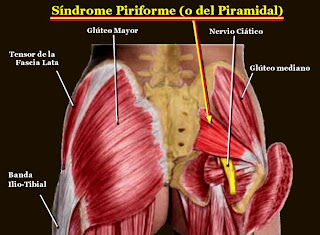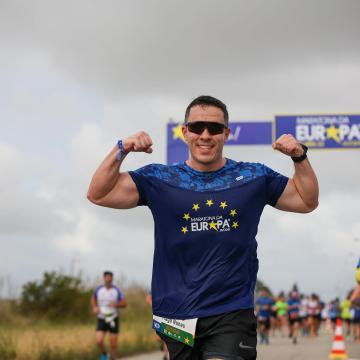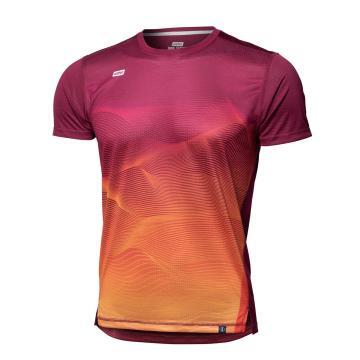Subscribe to our newsletter to find out about all the news and promotions, and automatically receive a welcome discount coupon in your email.
Piriformis Syndrome

In runners, it is very common to find the cause: pyramidal, a small muscle located in the pelvis used above all in the running gesture (stride, impacts, strong rhythms) and is the cause of the symptoms of pyramidal or piriformis syndrome.
It is due to entrapment of the sciatic nerve in the notch area. Said nerve runs in that space between two muscles: one is the pyramidal of superoposterior situation; and the other, the anteroinferior internal obturator. In athletes who have great muscular development and little fat content, such as long-distance runners, this space narrows, mainly in internal rotation, and the nerve suffers compression.
CAUSES of piriformis syndrome
The causes that cause pain at the level of this muscle of the sacrum are numerous:
– Running on hard surfaces, such as asphalt or sidewalks.
– Running over rough terrain.
– Running on hard surfaces, such as asphalt or sidewalks.
– Running over rough terrain.
– Starting an exercise program after a long period of inactivity. Increase intensity or duration of exercise too quickly.
– Running excessively pronating or worn shoes.
– Sitting for long periods of time. (Sitting in an incorrect posture produces eleven times more pressure on the third lumbar disc than a supine position. This working position is a necessity, but it is detrimental when treating disc injuries)
Other causes:
Biomechanical alterations:
The main biomechanical alterations that contribute to piriformis syndrome are faulty foot and body mechanics, gait disturbances, and poor posture or sitting habits. Other causes can include spinal problems such as herniated discs and spinal stenosis.
Other biomechanical causes include: Insufficient mechanics when running or walking. Tight, firm, and stiff muscles in the back of the lower back, hips, and buttocks.
Running or walking with your toes pressed together
Excessive exercises for the buttocks
(kicks, squats), can cause “pyramidal syndrome”. This occurs more in of between 20 and 50 years old who try to reduce their buttocks with intense exercises, which far from favoring them, what it does is hypertrophy this muscle even more with the aggravating circumstance of "imprisoning" the sciatic nerve in their muscular mass and the worst thing is that they take a long time in realizing what is happening to them and why. They only refer the pain when the process is already aggravated. Later we will talk about step and its relation to these problems.
Many people, including doctors, confuse this syndrome with hip problems, bursitis, low back pain, thigh flexor tendonitis and true sciatica. Hence, it is necessary to be cautious and search through complementary tests (magnetic resonance imaging, radiography, ultrasonography and electromyography) for the exact diagnosis of these ailments.
The most common clinical signs of the syndrome
They are pain in the buttocks, close to the femur, when walking or when walking is suddenly interrupted, simple pains such as getting up or sitting down, pains if the legs are stretched in the lying position, pains if more intense physical activity is practiced and atrophy. gluteal depending on the duration of symptoms. The pains can increase even when lying in bed in full rest, which makes restful sleep uncomfortable.
“Piriformis syndrome can cause pain in the lower back, groin, perineum, buttocks, hips, and other areas, and can even cause dyspareunia (painful intercourse) and rectal pain with bowel movements. Piriformis problems are very diverse and very common, and fortunately they respond very well to therapeutic massages”.
From a podiatric point of view
Check if you tread is in PRONATION, since the Piriformis Syndrome and pronation go hand in hand as the foot causes the internal rotation of the femur and consequently the pyramidal contracture, at which level the sciatic nerve is as thick as the big toe.
What parts of the body are involved?
The lower lumbar spinal nerves exit the spine and join to form the sciatic nerve. The sciatic nerve leaves the pelvis with an opening called the sciatic notch.
The piriformis muscle begins within the pelvis. It connects to the sacrum, the triangular bone that sits between the pelvic bones at the base of the spine. The connection of the sacrum to the pelvic bones forms the sacroiliac joint.
What Causes This Problem?
Sciatica symptoms come from irritation of the sciatic nerve. It remains a mystery why the piriformis muscle sometimes begins to irritate the sciatic nerve. Many think the condition begins when the piriformis muscle goes into spasm and presses against the sciatic nerve, squeezing the nerve against the pelvic bone.
In some cases, the muscle can be damaged due to a fall on the buttock. Bleeding in and around the piriformis muscle forms a hematoma, pooling blood in that area. The piriformis muscle begins to swell and put pressure on the sciatic nerve. Soon the hematoma dissolves, but the muscle goes into spasm; that is, it is contracted.
The sciatic nerve remains irritated and continues to be a problem. The muscle eventually heals, but some of the muscle fibers within the piriformis muscle are replaced by scar tissue. Scar tissue is not as flexible and elastic as normal muscle tissue. The end result is that the piriformis muscle squeezes upwards and applies constant pressure against the sciatic nerve.
Symptoms:
Piriformis syndrome commonly causes pain radiating down the back of the leg. The pain may only be felt on one side, although it is sometimes felt on both sides. The pain may radiate all the way to the foot and may be mistaken for a herniated disc in the lumbar spine. Changes in sensation and weakness in the leg or foot are rare. Some people feel a sensation like a "vague buzzing" in the lower back of the leg.
The way to sit: some patients try to sit with the sore lateral buttock tilted without sitting fully in the chair.
Diagnosis:
A good medical history looking for family history (for example, any arthritis that runs in the family), a good physical examination and fine-tuning how it is is essential. the pain: if it affects your daily life, what positions or activities make your symptoms worse, past injuries. Your posture, how you walk, and where your pain is located are then examined.
Doctors use exploratory maneuvers to help find the cause of sciatica:
When straight leg raising (A) reproduces pain, a herniated disc is often the cause. If raising the leg has no effect, the crossed leg test demonstrated below (B) can be used to stretch the piriformis muscle for a pelvic location of sciatic nerve entrapment.
Your skin sensation, muscle strength, and reflexes are also tested, because it is difficult to distinguish pain that comes from the sacro-iliac joint from pain that comes from other spinal conditions.
In case there were some joints affected (infection or arthritis), a blood test would be ordered.
x-rays they can give an idea about how much wear the sacro-iliac joint presents; but it cannot detect if the nerve is irritated in the piriformis muscle.
MRI, would further refine the diagnosis, giving a more detailed picture of the soft tissues, including the piriformis muscle and the sciatic nerve. The increase in volume of the muscles, the narrowness of the gorge with hardly any fat and, with certain specific sequences, the edema of the perineurium can be seen.
Treating back pain by massaging the muscles of the buttocks using a tennis ball against a wall. Treat the entire area covered by the pocket. Spread your feet 30 foot (1 cm) or more away from the wall.
Transmission
Piriformis syndrome can be painful, but it is rarely dangerous and rarely leads to the need for surgery. Most people with this condition can reduce pain and manage the problem with simple methods, such as physical therapy. Apart from these treatments by the physiotherapist, trying to relax the muscle and Stretching, are they anti-inflammatory, local anesthetic injections (lidocaine) for a temporary relaxation that helps us to diagnose if when relaxing the muscle the irradiated pain disappears due to the sciatic nerve being imprisoned.
cortisone, for example, it can be mixed with anesthetic medication to reduce inflammation in the sciatic nerve.
Botulism injection therapy (also known as Botox injections) can be used to actually paralyze the piriformis muscle.
botulinum toxin it inhibits muscle contraction by blocking the release of acetylcholine into the neuromuscular space and thus produces muscle relaxation in the region of the injected muscle. For more than a decade, it has been used in adults and children with neurological diseases that present with muscle spasm, hypertonia and/or dystonia. Botulinum toxin has been shown to reduce pain and improve muscle function, increasing the functional capacity of many patients with different neurological disorders.
This causes the muscle to relax, thus avoiding pressure on the sciatic nerve. The effect of the Botox injection is not permanent; it only lasts a few months. In the meantime, however, it is hoped that a stretching program can be used to fix the problem. That is, by the time the injection wears off, the muscle may have been stretched enough times that the symptoms don't return.
Surgery can be considered; but generally only as a last resort. There are two procedures. The first is to cut the piriformis tendon where it joins the greater trochanter. The other method is to cut through the piriformis muscle to take pressure off the sciatic nerve. These procedures are usually done on an outpatient basis, meaning that you will be able to go home the same day as the surgery. In some cases, you may need to stay in the hospital overnight. Both procedures can be done under general anesthesia or under a spinal type of anesthetic (epidural).
Returning to the physical therapist, what he should do is evaluate your physical condition, exploring your back, the sacro-iliac joint and the hip. Physical therapy treatments for piriformis syndrome often begin with applications of heat. Heat is used to help the muscle relax, reducing spasm and pain.
Ultrasound it is another treatment option that can be set for deep heating in the buttock area. Ultrasound uses high frequency sound waves that are directed through the skin. The deep thermal effect of the ultrasound is ideal to prepare the piriformis muscle for the massage and to get the muscle to stretch it out. Deep massages and specialized forms of muscle tissue mobilization can be used initially. Your physical therapist can also position your hip and leg in a way that helps relax the signals that the sciatic nerve sends to the triquetrum.
in one's own house, the stretches, will be done often, once learned in the sessions of the physiotherapist. One more, this time: Chair stretch
The goal of a rehabilitation program is that you can return to your sport or activity safely as soon as possible. If you return to practice too early, your injury can be aggravated, with the danger of permanent damage. Each person recovers from their injury at a different rate. Your return to sports or activity will depend on how quickly your nerve recovers and not on how many days or weeks have passed since your injury. In general, the longer you start treatment after you have symptoms, the longer it will take to heal.
42K · All rights reserved















Comments
Post a first comment for this entry!